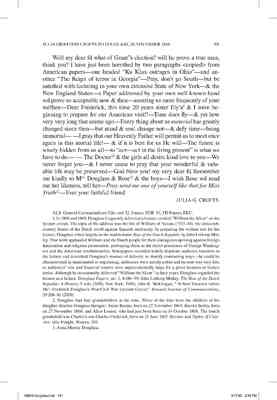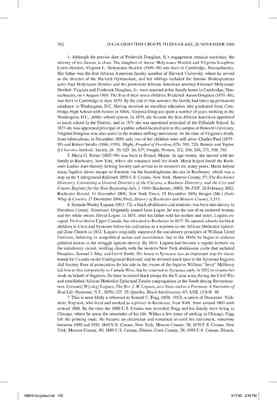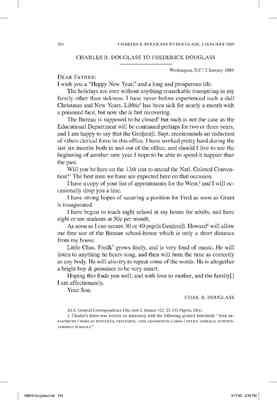Pages
page_0001
JULIA GRIFFITHS CROFTS TO FREDERICK DOUGLASS
Gateshead-on-Tyne[, Eng.] 26 Nov[ember 1868].
MY VERY DEAR FRIEND,
I was so glad to receive your last letter & to find from its contents that you are pretty well in health & active in lecturing, as well.
Oh: how I thought of the old times, when you named your proposed Lecture on “William the Silent”!1In 1868 and 1869, Douglass frequently delivered a lecture entitled “William the Silent” on the lyceum circuit. The topic of the address was the life of William of Nassau (1533–84), the sixteenth-century leader of the Dutch revolt against Spanish suzerainty. In preparing the written text for the lecture, Douglass relied largely on the multivolume Rise of the Dutch Republic by John Lothrop Motley. That work applauded William and the Dutch people for their courageous uprising against foreign domination and religious persecution, portraying them as the direct precursors of George Washington and the American revolutionaries. Newspapers recorded widely disparate audience reactions to the lecture and described Douglass’s manner of delivery in sharply contrasting ways—he could be characterized as unanimated or engrossing; audiences were merely polite and turnout was very low, or audiences’ size and financial returns were unprecedentedly large for a given location or lecture series. Although he occasionally delivered “William the Silent” in later years, Douglass regarded the lecture as a failure. Douglass Papers, ser. 1, 4: 186–99; John Lothrop Motley, The Rise of the Dutch Republic: A History, 5 vols. (1856; New York, 1900); John R. McKivigan, “ ‘A New Vocation before Me’: Frederick Douglass’s Post-Civil War Lyceum Career,” Howard Journal of Communications, 29: 268–81 (2018).—Pray, send it here: in some way— next to hearing it, reading it will be a treat—I am longing to know when it is to be delivered? & how it succeeds?—so prithee dear fd write soon, & tell me all about it—It strikes me you are at home this very day, (Thursday 26th) eating your “Thanksgiving Turkey”—How utterly vain all wishes are! So, I will not say what I wish; (yet—but—or though will come) I should like to see all the wee grandchildren toddling around grandpa’s knee2Douglass had four grandchildren at the time. Three of the four were the children of his daughter Rosetta Douglass Sprague: Annie Rosine, born on 27 November 1864; Harriet Bailey, born on 27 November 1866; and Alice Louise, who had just been born on 14 October 1868. The fourth grandchild was Charles’s son Charles Frederick, born on 21 June 1867. Bernier and Taylor, If I Survive, xlix; Fought, Women, 310.—I sh[oul]d think grandma3Anna Murray Douglass. too will be very fond of the little ones—Is Fred’s intended a nice, bright girl?4Although the precise date of Frederick Douglass, Jr.’s engagement remains uncertain, the identity of his fiancée is clear. The daughter of Aaron Molyneaux Hewlett and Virginia Josephine Lewis Hewlett, Virginia L. Molyneaux Hewlett (1849–89) was born in Cambridge, Massachusetts. Her father was the first African American faculty member of Harvard University, where he served as the director of the Harvard Gymnasium, and her siblings included the famous Shakespearean actor Paul Molyneaux Hewlett and the prominent African American attorney Emanuel Molyneaux Hewlett. Virginia and Frederick Douglass, Jr., were married at her family home in Cambridge, Massachusetts, on 4 August 1869. The first of their seven children, Frederick Aaron Douglass (1870–86), was born in Cambridge in June 1870. By the end of that summer, the family had taken up permanent residence in Washington, D.C. Having received an excellent education (she graduated from Cambridge High School with honors in 1868), Virginia Douglass spent a number of years working in the Washington, D.C., public school system. In 1870, she became the first African American appointed to teach school in the District, and in 1871 she was appointed principal of the Hillsdale School. In 1873 she was appointed principal of a public school located next to the campus of Howard University. Virginia Douglass was also active in the woman suffrage movement. At the time of Virginia’s death, from tuberculosis, in December 1889, only two of her children were still alive: Charles Paul (1879– 95) and Robert Smalls (1886–1910). Blight, Prophet of Freedom, 678, 700, 720; Bernier and Taylor, If I Survive, lxxxviii–lxxxix, 26–30, 625–26, 637; Fought, Women, 212, 266, 268, 271, 308, 310.—
I am sending this via good Miss Porter5Maria G. Porter (1805–96) was born in Bristol, Maine. At age twenty, she moved with her family to Rochester, New York, where she remained until her death. Maria helped found the Rochester Ladies Anti-Slavery Sewing Society and served as its treasurer for many years. Maria helped many fugitive slaves escape to freedom via the boardinghouse she ran in Rochester, which was a stop on the Underground Railroad. 1850 U.S. Census, New York, Monroe County, 57; The Rochester Directory, Containing a General Directory of the Citizens, a Business Directory, and the City and County Register for the Year Beginning July, 1 1880 (Rochester, 1880), 58; FDP, 26 February 1852; Rochester Herald, 14 December 1896; New York Times, 15 December 1896; Bangor (Me.) Daily Whig & Courier, 17 December 1896; Peck, History of Rochester and Monroe County, 1: 243.—to be born in aid of the Rochester A. S. Society, I am forwarding £5— —This host also takes £5—to Loguen6Jermain Wesley Loguen (1813–72), a black abolitionist and minister, was born into slavery in Davidson County, Tennessee. Originally named Jarm Logue, he was the son of an enslaved woman and her white owner, David Logue. In 1835, after his father sold his mother and sister, Loguen escaped. He first fled to Upper Canada, but relocated to Rochester in 1837. He opened schools for black children in Utica and Syracuse before his ordination as a minister in the African Methodist Episcopal Zion Church in 1842. Loguen originally supported the antislavery principles of William Lloyd Garrison, believing in nonpolitical action and nonviolence, but in the 1840s he began to endorse political means in the struggle against slavery. By 1844, Loguen had become a regular lecturer on the antislavery circuit, working closely with the western New York abolitionist circle that included Douglass, Samuel J. May, and Gerrit Smith. His house in Syracuse was an important stop for slaves bound for Canada on the Underground Railroad, and he devoted much time to the Syracuse Fugitive Aid Society. Fear of prosecution for his role in the rescue of the fugitive William “Jerry” McHenry led him to flee temporarily to Canada West, but he returned to Syracuse early in 1852 to resume his work on behalf of fugitives. He later recruited black troops for the Union army during the Civil War and established African Methodist Episcopal Zionist congregations in the South during Reconstruction. J[ermain] W[esley] Loguen, The Rev. J. W. Loguen, as a Slave and as a Freeman: A Narrative of Real Life (Syracuse, N.Y., 1859), 425–33; Quarles, Black Abolitionists, 67; ANB, 13: 848–49.— —& in the packet to Syracuse I am enclosing a small note to Mr. Fogg7This is most likely a reference to Samuel C. Fogg (1836–1912), a native of Doncaster, Yorkshire, England, who lived and worked as a printer in Rochester, New York, from around 1860 until around 1880. By the time the 1880 U.S. Census was recorded, Fogg and his family were living in Chicago, where he spent the remainder of his life. Within a few years of settling in Chicago, Fogg left the printing trade. He became an electrician and remained so until his retirement, sometime between 1900 and 1910. 1860 U.S. Census, New York, Monroe County, 38; 1870 U.S. Census, New York, Monroe County, 80; 1880 U.S. Census, Illinois, Cook County, 28; 1900 U.S. Census, Illinois, Cook County, 20A; “Cook County, Illinois, Death Index, 1878–1922,” Ancestry.com; “U.S., City Directories, 1822–1995.”—re-enclosed to Rev: S. J. May—Whom I, have requested to read it before forwarding it to that graceless individual!!
To Mr Fogg I say, “I now write again to request that you will oblige me by either sending the money entire or in instalments to me direct or by way of my friend Mr Frederick Douglass, who will furnish you with the necessary receipts on payment of the whole”—Perhaps Mr May’s8Samuel J. May. “moral suasion” may stir him life!—
page_0002
Well my dear fd what of Grant”s election? will he prove a true man, think you? I have just been horrified by two paragraphs <copied> from American papers—one headed “Ku Klux outrages in Ohio”—and another “The Reign of terror in Georgia”—Pray, don’t go South—but be satisfied with lecturing in your own extensive State of New York—& the New England States—a Paper addressed by your own well known hand wd prove so acceptable now & then—assuring us more frequently of your welfare—Dear Frederick, this time 20 years sister Ely’a9Elizabeth “Eliza” Griffiths Dick (1822–90) became a staunch abolitionist while growing up in England. Eliza and Julia Griffiths first met Douglass when he was in London for a farewell soiree in 1847, and according to Douglass, the sisters showed him around the city “to see and enjoy sights curious in works of art, as well as natural beauty” and were “to me devoted friends in a strange land.” Eliza helped her sister raise funds for the antislavery cause, particularly Douglass’s newspapers North Star and Frederick Douglass’ Paper, as well as for the bazaars in Rochester. In 1849, Julia and Eliza traveled to the United States, sailing on the S.S. Sarah Sands from Liverpool and arriving in New York on 2 May 1849. (Both are listed in the ship’s manifest as spinsters from England.) Soon after their arrival in New York, Douglass and the Griffiths sisters were attacked while walking along the Battery. The incident was reported on both sides of the Atlantic. Julia and Eliza traveled with Douglass to several antislavery meetings and boarded the steamship Alida in New York together, where Julia publicly protested against the racism directed toward Douglass by Captain Frederick W. Stone. The sisters stayed in Douglass’s home in Rochester until Eliza moved to Toronto, Canada, in 1850 with John Dick, her new husband and the North Star’s printer. The Dicks eventually immigrated to New Zealand. Some historians have argued that it was Eliza who first purchased the mortgage on Douglass’s house in 1849, after which she transferred it to Julia in April 1851. Fought, Women, 341; “Immigrant Ships Transcribers Guild (passenger manifest),” ImmigrantShips.net; “1851 Canada Census,” FamilySearch.org; “New Zealand, Cemetery Transcriptions, 1840–1981,” FamilySearch.org. & I were beginning to prepare for our American visit!!—Time does fly—& yet how very very long that seems ago—Every thing about us material has greatly changed since then—but mind & soul change not—& defy time—being immortal— —I pray that our Heavenly Father will permit us to meet once again in this mortal life!— & if it is best for us He will—The future is wisely hidden from us all—to “act—act in the living present” is what we have to do.— — The Doctor10Henry Only Crofts (1814–1880) was born in Lichfield, Staffordshire, and became an ordained Methodist minister in 1835. He was a member of the New Connexion Conference from 1840 to 1842 and traveled to Montreal, Canada, in 1843. While abroad, he was stationed in Montreal and Toronto, serving four times as superintendent of missions and president of the Canadian Conference. He left Canada in 1852 and settled in Halifax, where he married Julia Griffiths in 1859. Later that year, the couple organized several meetings at the Mechanics Hall in Halifax for Douglass when he arrived for his second visit to Britain; they also opened their home to him while he stayed in the town. Crofts supported his wife’s antislavery activism, and both worked to increase subscribers to Frederick Douglass’ Paper. Henry died in St. Neots in January 1880. “England and Wales, Civil Registration Marriage and Death Indexes,” Ancestry.com; Fought, Women, 145, 173; University of Manchester Library Index of Methodist Ministers, library.manchester.ac.uk.; Hilary M. Carey, God’s Empire: Religion and Colonialism in the British World c. 1801–1908 (Cambridge, Eng., 2011), 187–89. & the girls all desire kind love to you—We never forget you—& I never cease to pray that your wonderful & valuable life may be preserved—God bless you! my very dear fd Remember me kindly to Mrs. Douglass & Rose11Rosetta Douglass Sprague. & the boys—I wish Rose wd send me her likeness, tell her—Pray send me one of yourself like that for Miss Truth12Sojourner Truth (1797–1883) was born a slave in Ulster County, New York. Named Isabella at birth, she passed through a number of owners before achieving freedom in 1827 and acquiring the surname Wagener from a Quaker family. A deeply religious woman who claimed to see visions and hear the voice of God, she renamed herself “Sojourner Truth” after receiving a vision to evangelize in the eastern states. Her involvement with the Northampton Association of Education and Industry, a communal farm in Massachusetts run by George W. Benson, William Lloyd Garrison’s brotherin-law, first brought her into contact with Frederick Douglass. Over the years, the two frequently shared the speaker’s platform at antislavery and women’s rights meetings. With Olive Gilbert, a white woman, as her amanuensis, Truth produced an autobiography in 1850. That book, her association with such prominent people as Harriet Beecher Stowe, Elizabeth Cady Stanton, and Abraham Lincoln, and her sometimes flamboyant speeches and behavior gave rise to many apocryphal stories about her. From 1850 until her death, she lived in Battle Creek, Michigan. Sojourner Truth, The Narrative of Sojourner Truth: A Northern Slave, ed. Olive Gilbert (Boston, 1850); Arthur Huff Fauset, Sojourner Truth: God’s Faithful Pilgrim (Chapel Hill, N.C., 1938); Hertha Pauli, Her Name Was Sojourner Truth (New York, 1962); Nell Irvin Painter, Sojourner Truth: A Life, a Symbol (New York, 1996), 160–63; NAW, 3: 2. —Ever your faithful friend
JULIA G. CROFTS.
ALS: General Correspondence File, reel 32, frames 352R–54, FD Papers, DLC.




